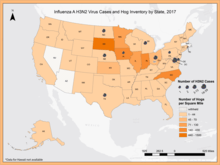2017–18 United States flu season
The 2017–18 United States flu season covered influenza activity taking place in the United States from late 2017 through early 2018.[1] The predominant strain of influenza was H3N2.[2] During the spring months of March–May, influenza B virus became dominant.[3]
| Influenza (Flu) |
|---|
 |
| Types |
|
| Vaccines |
|
| Treatment |
| Pandemics |
|
| Outbreaks |
|
| See also |
|
In all states except Hawaii and Oregon, the distribution of influenza was indicated as widespread, including 32 states that had high flu activity.[2][4] The flu season was exacerbated by a shortage of IV bags caused by IV bag plant closures in Puerto Rico following Hurricane María.[5]
Effects
The United States Centers for Disease Control and Prevention (CDC) began counting the 2017–2018 "flu season" as October 2017, and by early February 2018, the epidemic was still widespread and increasing overall. By February 2018, the CDC said that the circulating virus strains included both B strains (Yamagata and Victoria), H1N1 and H3N2.[6] On February 10, 2018, Fortune reported that influenza in the United States was killing up to 4,000 Americans a week, likely to far outstrip the rate of deaths in the 2009–2010 season. An expert said that the main time of the flu that year had not "changed enough from previous seasons to be considered a novel strain." In the first week of February, deaths from influenza and pneumonia were responsible for one of every ten deaths in the US, with 4,064 from pneumonia or influenza recorded in the third week of 2018, according to CDC data. The CDC also reported 63 child deaths at that point, half of which were not considered medically high risk, and only about 20 percent who were vaccinated.[7][8] Only two of those deaths were babies under six months old.[9]
The 2017-2018 flu season was severe for all populations and resulted in an estimated 959,000 hospitalizations and 79,400 deaths. This is the highest number of patient claims since the 2009 flu season.[10] 186 pediatric deaths were reported to the CDC.[3] It is estimated there were more than 600 pediatric deaths related to influenza. This estimation is made because every child death is not tested for influenza.[10]

Effects in New York
On February 10, 2018, officials in New York City confirmed the third pediatric flu death for the 2017–2018 season. The week prior, 43 states reported high patient traffic for the flu, with flu remaining widespread in each state except Hawaii and Oregon.[4]
Effects in California
California was hit especially hard by the 2017–18 flu outbreak.[11] In California as of 6 January, twenty-seven people under the age of 65 died from flu since October, nine times as many as the prior year. The Ronald Reagan UCLA Medical Center emergency room, which often caters to about 140 patients daily, had more than 200 patients on one of those days.[12] By 19 January, seventy-four people under the age of 65 had died in California, with thirty-two of those deaths occurring in the preceding week, making it the deadliest week of the flu season so far.[13]
By February 9, 2018, the national rate for flu-like symptoms for patients visiting clinics had reached "well above" seven percent, a rate last seen during the H1N1 swine flu epidemic of 2009.[14] According to the Los Angeles Times, 163 people under the age of 65 had died of the flu since October 2017, compared to 40 deaths during the same time period the previous year. Of those 163 deaths, 36 had died during the first week of February; the same article also noted that the peak of the flu season has apparently passed as reports of new cases have declined.[15]
Effects in Washington state
On February 11, 2018, the Seattle Times reported that "things [were] improving" in Washington state. At the time, the state had seen 151 flu-related fatalities, lower than the total of 214 that time the year before.[16]
Effects in Delaware
On February 12, 2018, Delaware announced that it had seen six deaths and 995 confirmed flu cases in seven days, making it the state's highest weekly total on record.[17]
Effects in Minnesota
On February 11, 2018, United States Senator Amy Klobuchar from Minnesota announced a new bill called the Flu Vaccine Act, calling for further research on a better vaccine at the US National Institutes of Health. At the time, there had been 400 outbreaks of flu that season in Minnesota's schools, and 130 outbreaks in long-term care facilities, with one child in the state dying. Additionally, Klobuchar continued to push the US Food and Drug Administration to fix the national IV bag and saline shortage, for adversely affecting the treatment of flu symptoms.[18]
Analysis of the flu season
According to the director of the Center for Disease Control and Prevention's influenza branch in January 2010, it was the first flu season where "we've had the entire continental US" show the same "widespread" flu activity, excluding the District of Columbia and Hawaii.[19] Twenty-six of those states were classified by the CDC as having "high" activity in January 2018.[20]
In January 2018, analyzing the reason for the spike, The Atlantic noted that the flu season was possibly worse because the dominant circulating strain was the H3N2 strain, which for unknown reasons tends to hit humans harder than other strains and result in worse flu seasons when dominant.[19] Also, the H3N2 strain, according to the CDC, affects elderly and young children more than other strains, resulting in more severe hospitalizations and deaths.[20]
The Atlantic also noted that the 2017 vaccine for the flu was only ten percent effective against H3N2 in Australia. As the typical practice of studying and creating the current vaccines in chicken eggs tends to result in mutations, 2017 was the first year that researchers used dog cells rather than chicken eggs to create the H3N2 component of the vaccine Flucelvax. However, due to cost, most Americans did not get Flucelvax in 2017 and 2018 and likely received vaccines grown with chicken eggs. The Atlantic noted that the vaccine still protected against other strains such as the H1N1 and B virus, and did provide at least some immunity to H3N2.[19]
In January 2018, The Atlantic also noted that the severity of the flu season in the United States may have been increased by a shortage of IV bags in hospitals. The shortage resulted from the Hurricane Maria blackout in Puerto Rico, where a great many medical supplies are manufactured. The article noted that hospitals normally go through hundreds of IV bags a day to replenish fluids and give drugs, but during the shortage, some hospitals had resorted to directly injecting drugs into the vein via an IV push.[19] Time also published an article in 2018 arguing that the United States had become complacent concerning the flu, and that more needed to be done.[21]
References
- "The Flu Season - Seasonal Influenza (Flu) - CDC". Cdc.gov. 7 April 2017. Retrieved 10 January 2018.
- Wright, Pam (9 January 2018). "Widespread Flu Hits 46 States". weather.com. The Weather Channel. Retrieved 14 January 2018.
- CDC (2019-09-05). "What You Should Know for the 2017-2018 Influenza Season". Centers for Disease Control and Prevention. Retrieved 2019-10-30.
- "NYC confirms 3rd child flu death as epidemic gets worse". 9 February 2018.
- "Flu Widespread in 46 States" (video). weather.com. The Weather Channel. 10 January 2018. pp. 00:25-00:36. Retrieved 13 January 2018.
- CNN, Susan Scutti,. "16 more children dead from flu, CDC says".CS1 maint: extra punctuation (link)
- "The Flu is Killing Up to 4,000 Americans a Week".
- "Flu Is Causing 1 in 10 American Deaths and Climbing". 9 February 2018 – via www.bloomberg.com.
- "This flu season has killed 53 kids so far. Here's what worried parents should do".
- "Estimated Influenza Illnesses, Medical visits, Hospitalizations, and Deaths in the United States — 2017–2018 influenza season | CDC". www.cdc.gov. 2019-03-26. Retrieved 2019-10-30.
- Criss, Doug (13 January 2017). "Mudslides, wildfires, earthquakes and flu. 2018's off to a rough start in California". cnn.com. CNN. Retrieved 14 January 2018.
- Karlamangla, Soumya. "Severe flu brings medicine shortages, packed ERs and a rising death toll in California". Latimes.com. Retrieved 7 January 2018.
- Karlamangla, Soumya. "Death toll jumps sharply after California experiences its worst week of the flu season – LA Times". Los Angeles Times. Retrieved 22 January 2018.
- "Minnesota's flu season is worse than expected, and it's not done yet".
- Karlamangla, Soumya. "Flu deaths reach a high, but outbreak shows signs of easing – LA Times". Los Angeles Times. Retrieved 9 February 2018.
- "'Things are improving': What you need to know about flu season in Washington state". 9 February 2018.
- "State: In one week 6 die of flu, record 995 cases".
- "With Flu Getting Worse, Klobuchar Calling For More Vaccine Research". 11 February 2018.
- Zhang, Sarah. "The Perfect Storm Behind This Year's Nasty Flu Season".
- CNN, Jacqueline Howard,. "Deadly flu season hits California hard".CS1 maint: extra punctuation (link)
- "Our Complacency About the Flu is Killing Us". Time.